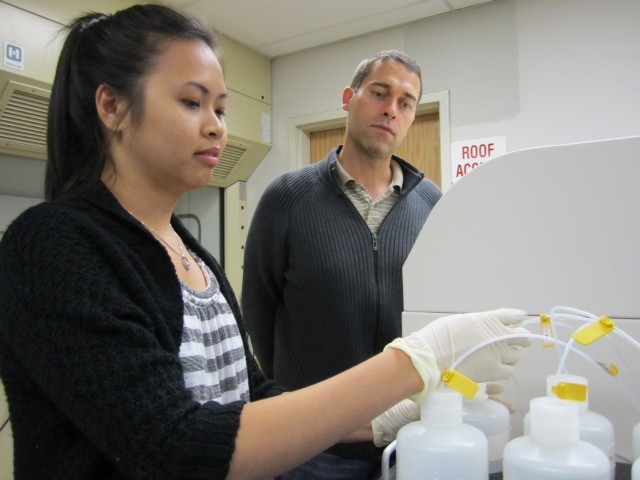CLU examines farmworker health risks
$150,000 grant to fund Oxnard pesticide study

Huong (Ivy) Nguyen, a sophomore chemistry major from Vietnam, and chemistry professor Grady Hanrahan analyze samples.
(THOUSAND OAKS, Calif. - Jan. 24, 2012) California Lutheran University has received a $150,000 grant to research environmental justice in Oxnard.
The California Wellness Foundation awarded the two-year grant for two professors and selected student researchers to assess farmworkers' exposure to pesticides, their knowledge of related health risks, and their ability to advocate for themselves. Based on the findings, the researchers will develop policy recommendations for promoting social justice in low-income communities of Ventura County.
Grady Hanrahan, the John Stauffer Endowed Professor of Analytical Chemistry, and Haco Hoang, an associate professor of political science, are the lead researchers. Students will assist with the project in the summer. Kaitlyn Noli, a Thousand Oaks resident who graduated with a degree in global studies in 2011, and Huong (Ivy) Nguyen, a sophomore chemistry major from Vietnam, will work on the project full time this summer. Both were members of a team of students that conducted initial research for the project last summer.
By testing water, soil and urine samples, the researchers are monitoring exposure to pesticides and comparing the results for farmworkers and others who don't work or live near farms. They are also looking for correlations between pesticide exposure and household income. Initial findings have shown significant concentrations of pesticides in a small area of agricultural land and higher than normal levels of pesticide exposure among the farmworkers.
Team members are conducting community meetings to gather input, educate people and encourage action on environmental health issues in areas with high rates of pesticide exposure. They will present the project to farmworkers at a Mixteco/Indigena Community Organizing Project meeting in February and return in March to measure the pesticide exposure levels of volunteers.
Hanrahan and Hoang hope to increase public awareness about pesticide exposure, environmental health and channels for community input and action. As part of the project, they are assessing the effectiveness of media, such as Spanish-language radio, in communicating environmental health information.
The project is designed to promote community activism based on scientific findings and principles and to help the student researchers develop the skills to become agents of social change.
The faculty and student researchers plan to present preliminary findings at the International Making Cities Livable Conference to be held May 20 through 24 in Portland, Ore.